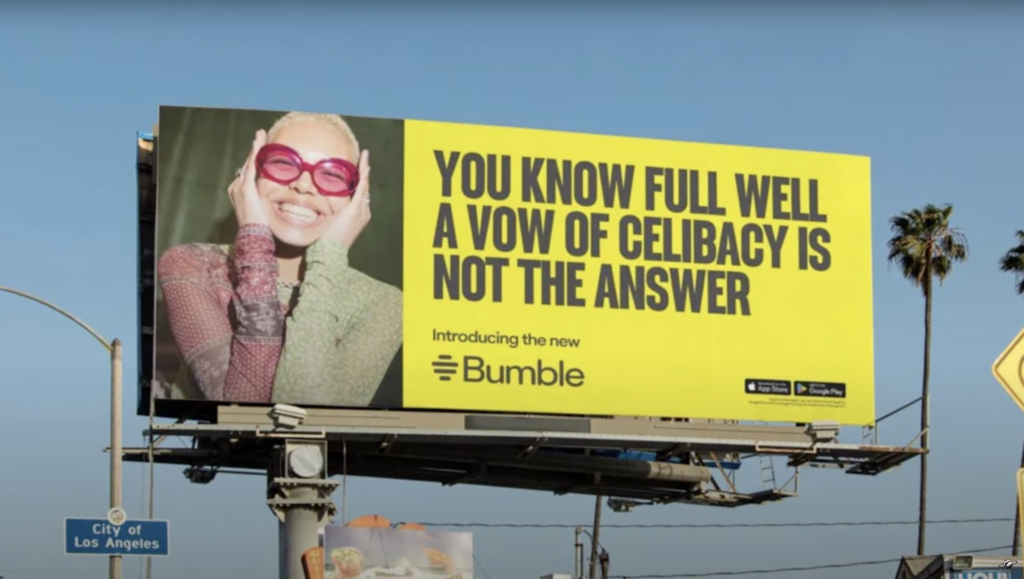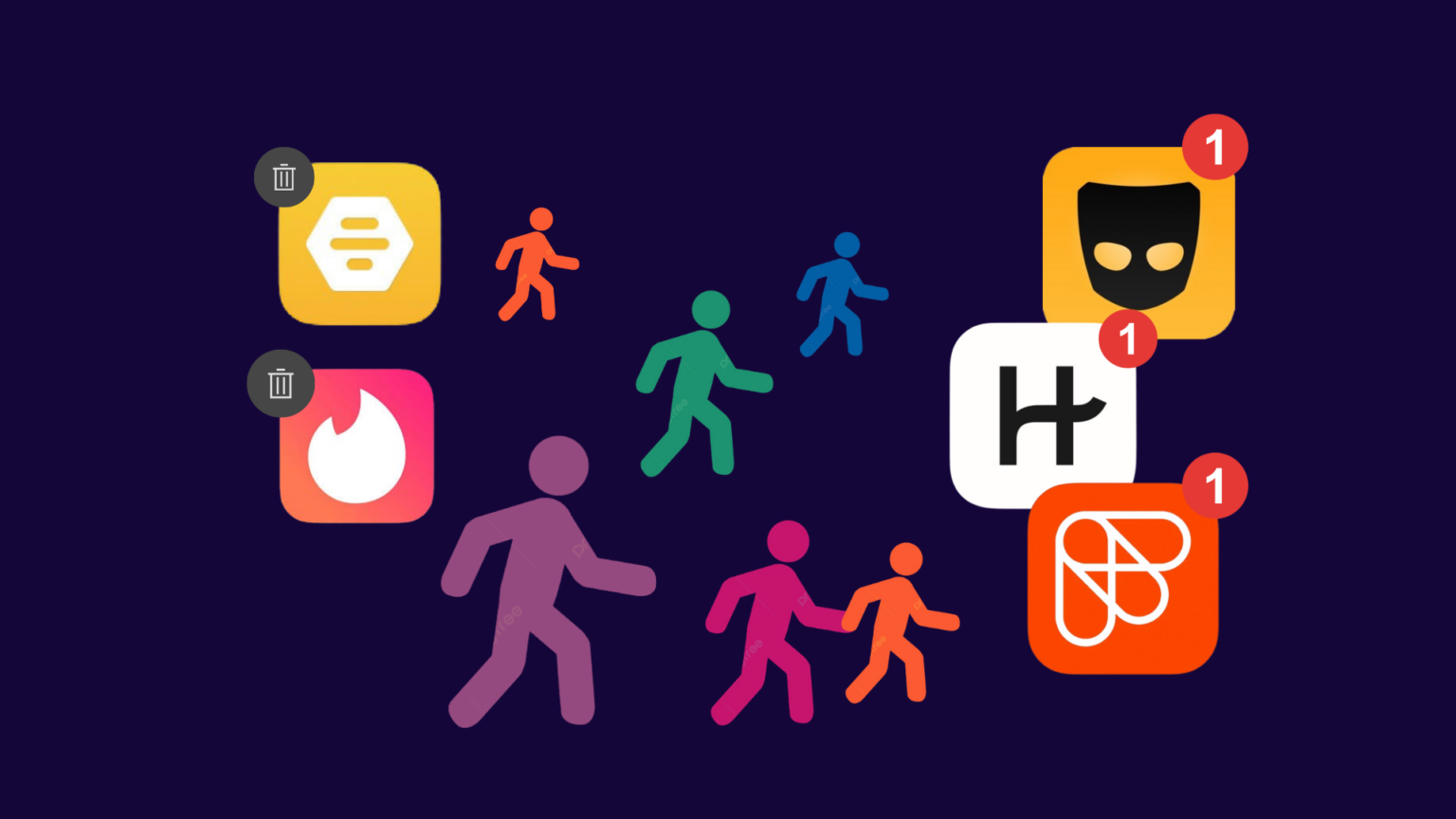From recent market data and reporting, a clear trend emerges: Legacy dating apps like Tinder and Bumble are losing steam. Quickly.
According to a March New York Times report, Tinder and Bumble have lost over $40 billion in market value over the past three years. Earlier this year, Bumble cut its headcount by 350 — 37% of its total workforce.
Bumble isn’t alone. Match Group, the largest of the dating app companies and owner of Tinder, OKCupid, and Hinge, was trading at nearly $170 per share in late 2021. The company’s stock closed this trading week at $37.21.
Dating App Exodus
Match Group and Bumble’s downloads have been on the decline since 2020. There were 21% fewer downloads of dating apps in 2023 than there were in 2021. Overall, dating app usage was down 16.5% from 2022–2023. To make matters worse, one survey found that nearly 65% of users deleted the app within one month of downloading it.
A Forbes survey found that 80% of Millennials and 79% of Gen Z reported feeling “burnt out” on dating apps, citing negative experiences including ghosting, rejection, lies, and time commitment.
Kerry Flynn writes for Axios about how dating apps “initially were novel, and had a unique twist” suggesting that new features might revive the moribund numbers.
While some cite a statistical demographic shift, others contend that part of the big problem for the sites is a changing user perception who don’t feel they are getting their money’s worth in creating new connections.
Adding to the dating app companies’ woes, less than 10% of all dating app users pay for premium features. According to a recent earnings report, the number of paying Tinder users declined 9% year over year.
Losing Touch With the Dating Scene
Legacy dating apps like Tinder and Bumble may be looking in the wrong direction about the causes of these declines.
To see how out of touch these companies’ are with their user base, look no further than Bumble’s recent marketing campaign.
Bumble reviewed data and found a problem common to dating apps: There were far fewer women than men. For every one woman on Bumble, there are two men seeking her attention. Tinder fares worse, with three men for every one woman.
Bumble realized that women were the limited variable. If they could attract more women to the platform, men would follow suite. In the meantime, Bumble realized that the more men the women interacted with, the higher number of users would stay engaged with the platform.
The company launched an ill-fated campaign encouraging women to engage in casual dating and hookup culture.

The campaign stirred significant backlash online. Many women found the messaging of the campaign to be offensive and transparent in Bumble’s own agenda of benefiting from women having causal encounters.
Though some women on Bumble may be dating causally, others hoped for serious relationships. Whatever they were seeking, women found the marketing campaign directly told women to engage in more casual hookups for Bumble’s benefit without even the slightest consideration for what the users may or may not want.
Bumble retracted the campaign two weeks after it launched and posted an apology on its Instagram.
“We made a mistake,” the statement reads. “We’re removing these ads from our global marketing campaign.”
One Size Does Not Fit All
Long-time established brands like Tinder also have to compete with newer, more niche dating apps. The Bumble Fumble and the rise of smaller-scale dating apps suggest cultural dating patterns are shifting — and Tinder and Bumble are failing to meet the occasion.
Between 2020–2024, Tinder’s monthly active users declined by approximately 19 million. Over the same period, LGBTQ-centric Grindr’s grew by about 5 million. Alternative, kink, and polyamory-focused Feeld gained 1.2 million users, and Match Group’s redeeming asset, Hinge, grew by 10 million.
Tellingly, both Grindr and Feeld enjoyed these growth rates over the same period that Tinder and Bumble have suffered declines in user base and engagement.
Moreover, Grindr reported a 34% year-over-year growth in revenue in its most recent earnings report. It also raised its revenue projections for 2024.
Alternative dating app Feeld enjoyed a 190% growth in monthly active users since 2021. The number of paid users grew by an impressive 550%. That means not only was Feeld gaining high numbers of new users, but a higher percentage were willing to pay for the service.
In other words, the users that left Tinder didn’t necessarily find their soulmate or succumb to swipe fatigue. They moved to smaller-scale platforms with higher concentrations of like-minded people and aligned romantic objectives.
In fact, Feeld’s biggest operational bottleneck is building the technical infrastructure to support a huge influx of users in recent years, the best kind of problem a business can have. Feeld’s growing popularity even had Cosmopolitan asking “Is Feeld like, a Mainstream Dating App Now?”
It’s not. Combined, Feeld and Grindr have less than 25% of Tinder’s monthly active users. Still, the inversion of growth trends may be a telling sign of the future of dating apps.
Can Dating Apps Seduce Users Back?
Of course, there will always be a market for conventional dating. In the wake of Bumble’s Fumble, Match Group may have a shot at redemption in the form of Hinge.
Match Group’s Hinge is enjoying a steady growth streak while flagship app Tinder has been struggling.
Whether Match Group will adapt to the landscape and nurture Hinge’s more personal, thoughtful, connection-focused model remains to be seen.
Or they may just do what they’ve always done: Leave users with an endless ocean of people to thoughtlessly swipe through; repeatedly badger users to pay for a la cart premium features; and forget “users” are actually people putting themselves out there to find meaningful connections, not human bait to attract more users or numbers in reports for investors.
Related: The Economics of No-Fault Divorce


